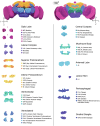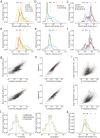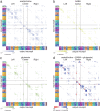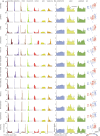Neuronal wiring diagram of an adult brain
- PMID: 39358518
- PMCID: PMC11446842
- DOI: 10.1038/s41586-024-07558-y
Neuronal wiring diagram of an adult brain
Abstract
Connections between neurons can be mapped by acquiring and analysing electron microscopic brain images. In recent years, this approach has been applied to chunks of brains to reconstruct local connectivity maps that are highly informative1-6, but nevertheless inadequate for understanding brain function more globally. Here we present a neuronal wiring diagram of a whole brain containing 5 × 107 chemical synapses7 between 139,255 neurons reconstructed from an adult female Drosophila melanogaster8,9. The resource also incorporates annotations of cell classes and types, nerves, hemilineages and predictions of neurotransmitter identities10-12. Data products are available for download, programmatic access and interactive browsing and have been made interoperable with other fly data resources. We derive a projectome-a map of projections between regions-from the connectome and report on tracing of synaptic pathways and the analysis of information flow from inputs (sensory and ascending neurons) to outputs (motor, endocrine and descending neurons) across both hemispheres and between the central brain and the optic lobes. Tracing from a subset of photoreceptors to descending motor pathways illustrates how structure can uncover putative circuit mechanisms underlying sensorimotor behaviours. The technologies and open ecosystem reported here set the stage for future large-scale connectome projects in other species.
© 2024. The Author(s).
Conflict of interest statement
T.M., K.L., S.P., D.I., N.K. and H.S.S. declare financial interests in Zetta AI.
Figures

















Update of
-
Neuronal wiring diagram of an adult brain.bioRxiv [Preprint]. 2023 Jul 11:2023.06.27.546656. doi: 10.1101/2023.06.27.546656. bioRxiv. 2023. Update in: Nature. 2024 Oct;634(8032):124-138. doi: 10.1038/s41586-024-07558-y. PMID: 37425937 Free PMC article. Updated. Preprint.
References
-
- MICrONS Consortium. Functional connectomics spanning multiple areas of mouse visual cortex. Preprint at bioRxiv10.1101/2021.07.28.454025 (2021).
MeSH terms
Substances
Grants and funding
- 200846/Z/16/Z/WT_/Wellcome Trust/United Kingdom
- RF1 MH123400/MH/NIMH NIH HHS/United States
- R01 NS054814/NS/NINDS NIH HHS/United States
- DP2 EY032737/EY/NEI NIH HHS/United States
- R35 NS111580/NS/NINDS NIH HHS/United States
- RF1 NS121911/NS/NINDS NIH HHS/United States
- R01 NS121911/NS/NINDS NIH HHS/United States
- R35 GM133698/GM/NIGMS NIH HHS/United States
- U24 NS126935/NS/NINDS NIH HHS/United States
- RF1 MH129268/MH/NIMH NIH HHS/United States
- RF1 MH120679/MH/NIMH NIH HHS/United States
- RF1 MH117815/MH/NIMH NIH HHS/United States
LinkOut - more resources
Full Text Sources
Molecular Biology Databases

